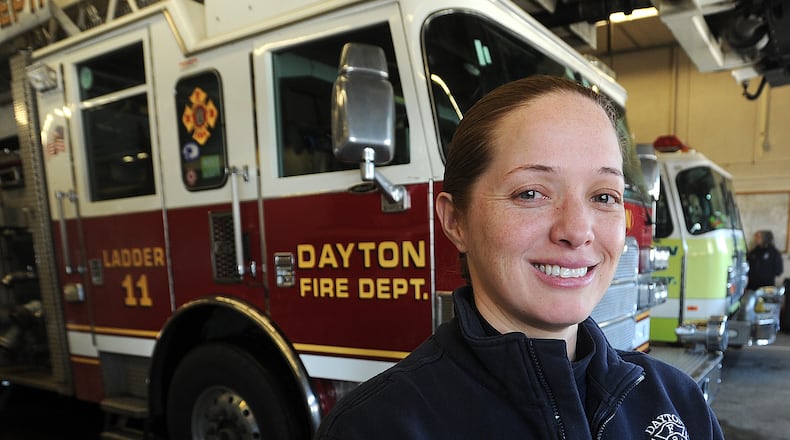National data shows about 8% of firefighters are women and only 4% who have chosen firefighting as a career are women. Those numbers are consistent with many local departments, a recent Dayton Daily News survey found.
Credit: CONTRIBUTED
Credit: CONTRIBUTED
Seven of 11 jurisdictions that responded to the survey reported fewer than 8% of their firefighters are women. Six, however, said that more than the 4% of their firefighting force were career firefighters.
Two local departments — Troy and Xenia — reported having no women firefighters.
Englewood had the highest percentage of women firefighters at 16.6 percent. Dayton, where Marshall serves as a captain — had the highest number with 33.
“This job in general is not for everyone — male or female,” Marshall said. “It’s dangerous. It can get dirty. It’s mentally and physically exhausting. It doesn’t matter whether you’re female or male, it’s just not for everybody.”
For Kring, it took some time for her to decide to make it her career, despite growing up in a Lewisburg home with a paramedic mother and a firefighter father.
“I actually changed my career choice many times,” she said during a shift at the Miami Valley Fire District headquarters in Miami Twp. The goal “was always wanting to help someone. But I never considered the fire service.”
A ‘passion’ for the job
Women have been working in the fire services since the 1800s, but the first female career firefighter was hired in 1974, according to Women in the Fire Service Inc.’s website.
Of the estimated 1.1 million career and volunteer firefighters nationwide in 2018, 93,700 are women, according to National Fire Protection Association.
Kring and Marshall said that one reason more women don’t become firefighters is the job’s physical demands. Both said they went through the same training as their male co-workers.
Kring, 24, said friends have told her “they grew up only seeing males do the job. So they never really knew they could pursue a career in the fire service.”
Marshall, 40, has been in the profession half her life. She works a standard 24 hours on/48 hours off shift.
“You just have to want to do it,” she said. “It’s just like any job — if you work hard and have a passion for it, you want to be here and you want to work,” you can succeed.
Several local departments responding to the Daily News survey said they are seeking to recruit more women.
Credit: FILE
Credit: FILE
In order to recruit more women, some officials said they are de-emphasizing qualifying agility tests where strength is a significant factor, and using job fairs and camps instructed by female members.
Troy Assistant Fire Chief Gary Stanley said in 2019 that city developed its apprenticeship program “to help bring diversity to our organization while providing opportunities for individuals that have not considered the fire/ems service as a career option.”
The number of female firefighters in Kettering has doubled to four since 2010, said Mary Azbill, Kettering community information manager.
She said the city works to ensure firefighter employment opportunities are posted to job boards such as womeninfire.org.
The Washington Twp. fire services have a goal of hiring of 11 firefighters/paramedics during a recruitment drive this spring and officials hope they can improve gender diversity.
The department has one part-time and eight full-time female firefighters, according to Kate Trangenstein, communications manager.
Huber Heights Fire Chief Keith Knisley said his department is preparing to hire four firefighter/paramedics, two of whom are women.
Those two are expected to compete the process next week, Knisley said Monday.
Recruiting methods vary
Instead of using a physical agility test based largely on strength, Englewood “moved to a firefighter abilities test that evaluates the candidate’s ability to perform state of Ohio Job performance requirements for firefighters,” Fire Chief Anthony Terrace said.
Since 2010, Englewood’s number of women firefighters has doubled from four to eight, he said.
In Fairborn, Fire Chief Dave Reichert said the department is evaluating recruitment “to help identify future full-time staff as well as to use the program to help the department better diversify.”
Dayton began using a Women’s Fire Camp instructed by women on staff, said Mike Rice, assistant fire chief.
The camp is “designed to showcase the firefighter profession and provides hands-on training opportunities,” Rice said.
In Vandalia, more than 15 women were working in 2010, according to Fire Chief Chad Follick. But “the availability of part-time personnel especially has become a challenge” regardless of gender, he said. The department now has five women firefighters.
Many of the departments responding to the survey agreed.
“Recruitment for public safety agencies across the nation has been challenging for the past decade … as the number of applicants has been on the decline for the past several years,” Oakwood Safety Director Alan Hill said.
As a fully consolidated safety department, each Oakwood member is certified as a peace officer, firefighter and EMT/paramedic, he said.
And, when hiring, “Oakwood is continually searching for that special individual who has the passion and desire to serve in all three capacities,” Hill added.
Emphasizing empathy
Hiring in general is “certainly more of a challenge today as the market has increased its demand from what it was a few years ago,” Knisley said. “The local supply has had difficulty in being able to keep up with this influx of demand.”
A way to increase the number of women in the fire service is to “have a more balanced view” of what it takes to be a good firefighter, according to a 2019 UCLA study.
“Traits like empathy, which are thought of as feminine, are just as legitimate and critical to success as traditionally masculine traits,” according to the findings. “Emphasizing those qualities can make it easier to imagine women in a firefighter’s job.”
About 4% of all calls in 2016 came in response to fires, according to the National Fire Protection Association. Two-thirds of calls requested medical assistance.
One method to recruit more females, Kring said, is to more heavily recruit in high schools.
Marshall said women considering a firefighting career shouldn’t be afraid to explore the career. If “it’s something you want to do … go through the process. Whether it’s physical agility or the written testing process, don’t think that you can’t do it just because you’re female.
“Some guys can’t do this job. It’s not basically male or female,” she added. “Do you want to do this job? Do you have the passion to be here? Are you a hard worker? That’s what it takes to really be good at this job.”
JURISDICTION FIREFIGHTERS FEMALE FIREFIGHTERS
Dayton 315* ` 33
Englewood 48 8
Fairborn 51* 2
Huber Heights 35 1
Kettering 82 4
**Miami Valley 64 2
Oakwood 29 2
Troy 42 0
Vandalia 51 5
***Washington Twp. 82 9
Xenia 42 0
*Includes all staff
**Includes Miamisburg and Miami Twp.
***Includes Centerville
BY THE NUMBERS
•1.1M: Career and volunteer firefighters in U.S. in 2018.
•93,700: Number who were female.
•15,200: Number of career female firefighters.
•1974: Year when first woman career firefighter was hired.
•33: Number of females in the Dayton Fire Department.
•16.6: Percentage of females in the Englewood Fire Department.
SOURCES: National Fire Protection Association, Women in the Fire Service, Inc., Dayton Fire Department, Englewood Fire Department.
About the Author



